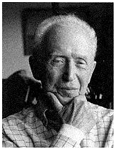Jacob Mincer
| Jacob Mincer | |
|---|---|
 |
|
| Born |
July 15, 1922 Tomaszów Lubelski, Poland |
| Died | August 20, 2006 (aged 84) New York City, NY, U.S. |
| Nationality | Polish-American |
| Institution |
NBER (1960–2006) Columbia University (1959–91) |
| Field | Labour economics |
| School or tradition |
Chicago School of Economics |
| Alma mater |
Columbia University (Ph.D.) Emory University (B.A.) |
| Doctoral advisor |
George Stigler Harold Barger |
| Doctoral students |
Reuben Gronau George Borjas |
| Influences | H. Gregg Lewis |
| Influenced | Gary Becker |
| Contributions | Idea of human capital Labour economics |
| Awards | IZA Prize in Labor Economics (2002) |
Jacob Mincer (July 15, 1922 – August 20, 2006), was a father of modern labor economics. He was Joseph L. Buttenwiser Professor of Economics and Social Relations at Columbia University for most of his active life.
Born in Tomaszów Lubelski, Poland, Mincer survived World War II prison camps in Czechoslovakia and Germany as a teenager. After graduating from Emory University in 1950, Mincer received his Ph.D. from Columbia University in 1957.
Following teaching stints at City College of New York, Hebrew University, and the University of Chicago, Mincer joined Columbia's faculty where he stayed until his retirement in 1991.
Mincer was also a member of the National Bureau of Economic Research from 1960 through his death.
Mincer died at his Manhattan home on August 20, 2006 due to complications from Parkinson's disease, according to his wife, Dr. Flora Mincer, and his daughters, Deborah Mincer (Sussman) and Carolyn Mincer.
Mincer was considered by many to be a father of modern labor economics. As a leading member of a group of economists known as the Chicago School of Economics, Mincer and Nobel Laureate Gary Becker helped to develop the empirical foundations of human capital theory, consequently revolutionizing the field of labor economics.
During his academic career, Mincer authored four books and hundreds of journal articles, papers and essays. Mincer's ground-breaking work: Schooling, Experience and Earnings, published in 1974, used data from the 1950 and 1960 Censuses to relate income distribution in America to the varying amounts of education and on-the-job training among workers. "He calculated, for example, that annual earnings rose by 5 to 10 percent in the 1950s and 1960s for every year of additional schooling. There was a similar, although smaller, return on investment in job training—and age played a role."
...
Wikipedia
